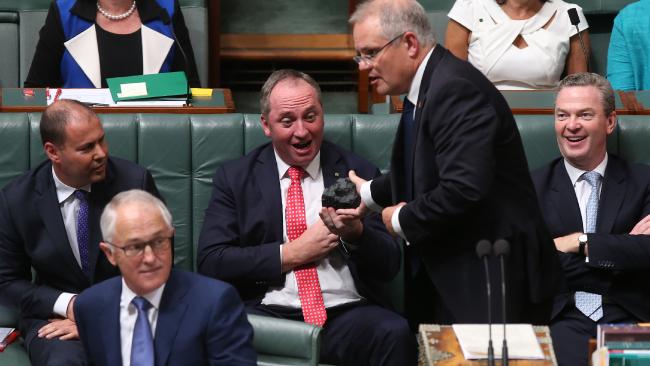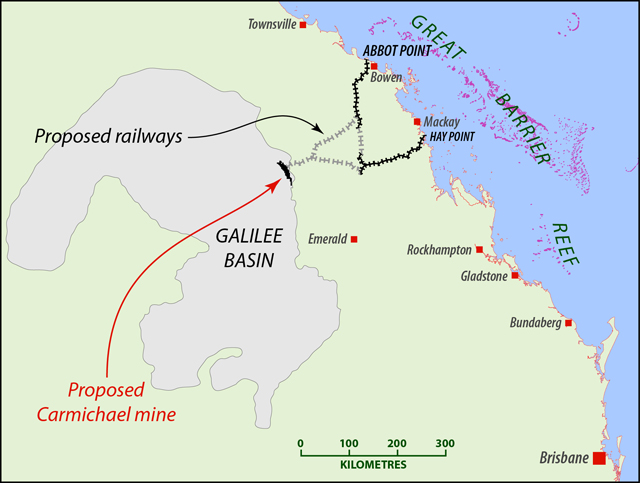It’s up to science, not Barnaby Joyce, to determine what’s real and what isn’t.

“Don’t be afraid of coal,” said Treasurer Scott Morrison to the Parliament on 10 February, before handing a lump of the black stuff to Barnaby Joyce. PHOTO Kym Smith, The Australian
In Barnaby Joyce’s eyes, people who support schemes like Queensland’s proposed $21.7 billion Carmichael coal mine are “realists”.
Those who don’t are people who prefer to “live with the butterflies”, and for them he had a grim warning last week on ABC Radio National’s Breakfast: “If you’re going to live with the butterflies you’re going to die with the butterflies.”
The deputy prime minister has a gift for the memorable image. Butterflies are the sort of species that, to the annoyance of many, can sometimes hold up a resource venture, and their brief, colourful lives conjure up flighty, frivolous behaviour. It fitted his purpose for that moment.
It also says everything about where he and his government sit in the great debate about climate, energy and the economy. He says developing one of the world’s biggest coal mines is realistic, when by any objective measure it’s pure lunacy.
Consider the outlay of nearly $1 billion of public money on a $2.2 billion railway line to carry vast quantities of coal to Abbot Point, on the coast near Bowen, so that it can be shipped through the Great Barrier Reef to India.

MAP: SouthWind
That’s despite an earlier statement by a spokesman for Adani, the Indian proponent of the mine, that the company could manage without government help. Multiple banks have declined to fund the project.
Barnaby Joyce and others in the government have been flaying renewable energy over its cost to taxpayers. But when you add the railway line to other rebates available to coal miners, nothing in renewables comes near the level of subsidy being proposed for the Carmichael venture.
In February Geoff Summerhayes, the Australian Prudential Regulation Authority board member responsible for insurance regulation, warned that directors who fail to consider foreseeable climate risk will be personally liable under law for breaching corporate care and diligence obligations.
If the board of the Northern Australia Development Facility approves the Adani loan, its members open themselves to legal action for breaching not just the Corporations Act but also public governance laws identified last week by environmental lawyers.
The financial risk from climate change referred to by Summerhayes threatens to make Carmichael a gigantic stranded asset, which is a big problem for the NAIF board right now. But there are more material issues around this mine.
Not unreasonably, indigenous traditional owners don’t like what the mine will do to their land, and local farmers have objected to their state government’s gift to Adani of rights to an unlimited quantity of groundwater, in a normally dry part of Queensland lacking surface water infrastructure.
The plan to ship the coal via the Great Barrier Reef signals contempt for an incomparable natural resource. The Reef is already being damaged as a direct consequence of carbon emissions. The mine would be a substantial contributor to its further destruction.
The federal and Queensland governments have said they want other players mining the vast coalfields of the Galilee Basin, over three times the size of Tasmania. Even without those extra players, Adani’s segment would yield nearly eight billion tonnes of greenhouse gases when burnt.
At our current greenhouse gas accumulation rate, science tells us to expect well over 3C of warming within the lifetimes of babies alive today, with a climate getting steadily more unstable. Future climate will be nothing like what we grew up with.
This is not my personal opinion, nor anyone else’s. It’s science. Scientific knowledge has been built over centuries by thousands of people using time-honoured methods to observe, record and analyse planetary systems. Their findings are tested and re-tested in the exacting process of peer review.
It’s up to science, not Barnaby Joyce, to determine what’s real and what isn’t. Our governments are treating that noble pursuit as something that can be shoved aside when it suits, arrogantly assuming that people will fall into place behind them. Australians are better than this.
Show your support for science by joining the March for Science, this Saturday from 1pm on Hobart’s Parliament Lawns. More information at www.marchforsciencehobart.org.
